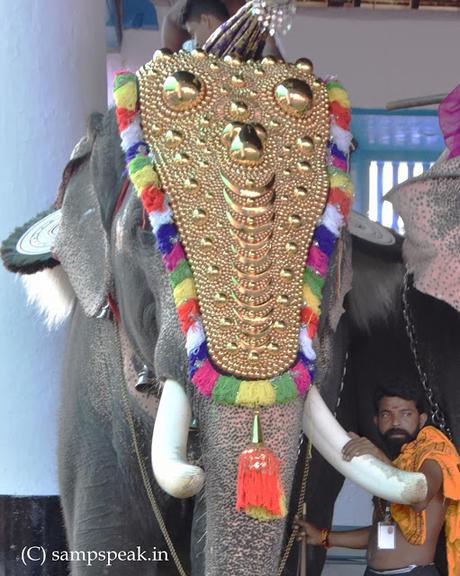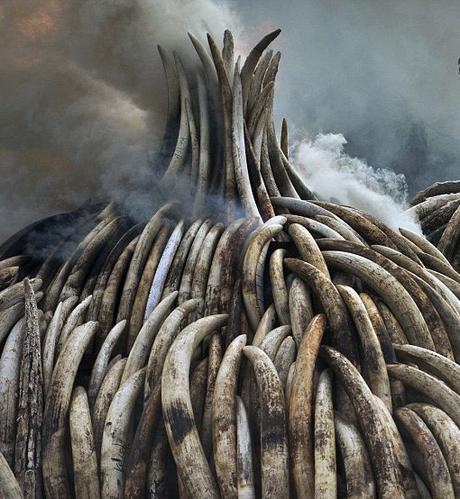I love elephants ~ one recent trip to Kerala, provided me so much of happiness – watching 15 elephants at Thirupunithura temple.The tall beautiful kombans had long tusks and were very majestic.
 Belying
their gigantic body, they move at great speed.When
male elephantsbattle in a show of
strength, they clash at high speeds, locking their tusks together. These
elongated incisor teeth are so strong that their wielders often use them to
wrestle and fling each other to the ground. But tusks aren’t only for
inflicting harm; outside of battle, elephants use them to clear paths through
vegetation and even move trees. Most remarkably, each elephant keeps the same
set of tusks—each weighing up to 400 kilograms—for its entire life.To perform these diverse tasks, the stuff
that makes up elephant tusks must be hard, strong and tough. This combination
of qualities is part of what has made ivory such a coveted element throughout
human history, selling at upwards of $2000 a kilogram ! Historically used in
billiard balls, piano keys and even hip replacements, ivory continues to be
valued today for jewelry and other luxury objects.
Unfortunately, the
value people have attached to elephant ivory has also fueled conflict and been
linked to organized crime, perpetuating a bloody trade that harms the pachyderm
alike. Almost all the world’s illegal ivory comes from elephants that have been
recently killed, researchers say. Sadly, African elephants have been poached
and killed cruelly in getting ivory.It
is not new, Ivory has been traded for hundreds of years by people in Africa and
Asia, resulting in restrictions and bans. Elephant ivory has been exported from
Africa and Asia for centuries with records going back to the 14th century BCE.
Throughout the colonization of Africa ivory was removed, often using slaves to
carry the tusks, to be used for piano keys, billiard balls and other
expressions of exotic wealth.
Belying
their gigantic body, they move at great speed.When
male elephantsbattle in a show of
strength, they clash at high speeds, locking their tusks together. These
elongated incisor teeth are so strong that their wielders often use them to
wrestle and fling each other to the ground. But tusks aren’t only for
inflicting harm; outside of battle, elephants use them to clear paths through
vegetation and even move trees. Most remarkably, each elephant keeps the same
set of tusks—each weighing up to 400 kilograms—for its entire life.To perform these diverse tasks, the stuff
that makes up elephant tusks must be hard, strong and tough. This combination
of qualities is part of what has made ivory such a coveted element throughout
human history, selling at upwards of $2000 a kilogram ! Historically used in
billiard balls, piano keys and even hip replacements, ivory continues to be
valued today for jewelry and other luxury objects.
Unfortunately, the
value people have attached to elephant ivory has also fueled conflict and been
linked to organized crime, perpetuating a bloody trade that harms the pachyderm
alike. Almost all the world’s illegal ivory comes from elephants that have been
recently killed, researchers say. Sadly, African elephants have been poached
and killed cruelly in getting ivory.It
is not new, Ivory has been traded for hundreds of years by people in Africa and
Asia, resulting in restrictions and bans. Elephant ivory has been exported from
Africa and Asia for centuries with records going back to the 14th century BCE.
Throughout the colonization of Africa ivory was removed, often using slaves to
carry the tusks, to be used for piano keys, billiard balls and other
expressions of exotic wealth.
 Apart
from killing of elephants, more gruesome was the treatment meted out to
slaves.Colonisation, keeping people as
slaves and more were the cruel habits of rich. In 1890, at the age of 32,
Conrad was appointed by a Belgian trading company to serve on one of its
steamers. While sailing up the Congo River from one station to another, the
captain became ill and Conrad assumed command. He guided the ship up the
tributary Lualaba River to the trading company's innermost station, Kindu, in
Eastern Kongo- and he is famous for his
novel “Heart of Darkness” published bu Joseph Conrad in 1899.In
this, Charles Marlow, the narrator, tells his story
to friends aboard a boat anchored on the River Thames. This setting provides
the frame for Marlow's story of his obsession with the successful ivory trader
Kurtz. Conrad offers parallels between London ("the greatest town on
earth") and Africa as places of darkness.Central to Conrad's work is the idea that there is little difference
between "civilised people" and those described as
"savages." Heart of Darkness implicitly comments on imperialism and
racism.
~ and .. … to Congo
and its period of darkness .. .. Leopold II (1835 – 1909) was King of the Belgians from 1865 to
1909. Born in Brussels as the second but eldest surviving son of Leopold I and
Louise of Orléans, he succeeded his father to the Belgian throne in 1865 and
reigned for 44 years until his death – the longest reign of any Belgian
monarch. He died without surviving sons. The current Belgian king descends from
his nephew and successor, Albert I.
Leopold fervently
believed that overseas colonies were the key to a country's greatness, and he
worked tirelessly to acquire colonial territory for Belgium. Leopold eventually
began to acquire a colony as a private citizen. The Belgian government lent him
money for this venture. After numerous unsuccessful schemes to acquire colonies
in Africa and Asia, in 1876 Leopold organized a private holding company disguised
as an international scientific and philanthropic association, which he called
the International African Society.In
Feb 1885, the Congo Free State, an area 76 times larger than Belgium, was
established under Leopold II's personal rule and private army, the Force
Publique.
Leopold was the founder and sole owner of the Congo Free State, a
private project undertaken on his own behalf. He used Henry Morton Stanley to
help him lay claim to the Congo, the present-day Democratic Republic of the
Congo. At the Berlin Conference of 1884–1885, the colonial nations of Europe
authorized his claim by committing the Congo Free State to improving the lives of the native inhabitants!. Leopold
ignored these conditions and ran the Congo using the mercenary Force Publique
for his personal gain. He extracted a fortune from the territory, initially by
the collection of ivory, and after a rise in the price of rubber in the 1890s,
by forced labor from the native population to harvest and process rubber. He
used great sums of the money from this exploitation for public and private
construction projects in Belgium during this period.
In that dark era, Leopold's
administration of the Congo was characterised by murder, torture, and
atrocities, resulting from notorious systematic brutality. The hands of men,
women, and children were amputated when the quota of rubber was not met. These
and other facts were established at the time by eyewitness testimony and
on-site inspection by an international Commission of Inquiry (1904). Millions
of the Congolese people died: modern estimates range from 1 million to 15
million deaths, with a consensus growing around 10 million. Reports of deaths and abuse led to a major
international scandal in the early 20th century, and Leopold was forced by the
Belgian government to relinquish control of the colony to the civil
administration in 1908.
Sad dark
saga of cruelty ! – yet another instance of Western World imposing their will
on other country in brutal manner.
With regards – S.
Sampathkumar
4th Feb
2020.
Apart
from killing of elephants, more gruesome was the treatment meted out to
slaves.Colonisation, keeping people as
slaves and more were the cruel habits of rich. In 1890, at the age of 32,
Conrad was appointed by a Belgian trading company to serve on one of its
steamers. While sailing up the Congo River from one station to another, the
captain became ill and Conrad assumed command. He guided the ship up the
tributary Lualaba River to the trading company's innermost station, Kindu, in
Eastern Kongo- and he is famous for his
novel “Heart of Darkness” published bu Joseph Conrad in 1899.In
this, Charles Marlow, the narrator, tells his story
to friends aboard a boat anchored on the River Thames. This setting provides
the frame for Marlow's story of his obsession with the successful ivory trader
Kurtz. Conrad offers parallels between London ("the greatest town on
earth") and Africa as places of darkness.Central to Conrad's work is the idea that there is little difference
between "civilised people" and those described as
"savages." Heart of Darkness implicitly comments on imperialism and
racism.
~ and .. … to Congo
and its period of darkness .. .. Leopold II (1835 – 1909) was King of the Belgians from 1865 to
1909. Born in Brussels as the second but eldest surviving son of Leopold I and
Louise of Orléans, he succeeded his father to the Belgian throne in 1865 and
reigned for 44 years until his death – the longest reign of any Belgian
monarch. He died without surviving sons. The current Belgian king descends from
his nephew and successor, Albert I.
Leopold fervently
believed that overseas colonies were the key to a country's greatness, and he
worked tirelessly to acquire colonial territory for Belgium. Leopold eventually
began to acquire a colony as a private citizen. The Belgian government lent him
money for this venture. After numerous unsuccessful schemes to acquire colonies
in Africa and Asia, in 1876 Leopold organized a private holding company disguised
as an international scientific and philanthropic association, which he called
the International African Society.In
Feb 1885, the Congo Free State, an area 76 times larger than Belgium, was
established under Leopold II's personal rule and private army, the Force
Publique.
Leopold was the founder and sole owner of the Congo Free State, a
private project undertaken on his own behalf. He used Henry Morton Stanley to
help him lay claim to the Congo, the present-day Democratic Republic of the
Congo. At the Berlin Conference of 1884–1885, the colonial nations of Europe
authorized his claim by committing the Congo Free State to improving the lives of the native inhabitants!. Leopold
ignored these conditions and ran the Congo using the mercenary Force Publique
for his personal gain. He extracted a fortune from the territory, initially by
the collection of ivory, and after a rise in the price of rubber in the 1890s,
by forced labor from the native population to harvest and process rubber. He
used great sums of the money from this exploitation for public and private
construction projects in Belgium during this period.
In that dark era, Leopold's
administration of the Congo was characterised by murder, torture, and
atrocities, resulting from notorious systematic brutality. The hands of men,
women, and children were amputated when the quota of rubber was not met. These
and other facts were established at the time by eyewitness testimony and
on-site inspection by an international Commission of Inquiry (1904). Millions
of the Congolese people died: modern estimates range from 1 million to 15
million deaths, with a consensus growing around 10 million. Reports of deaths and abuse led to a major
international scandal in the early 20th century, and Leopold was forced by the
Belgian government to relinquish control of the colony to the civil
administration in 1908.
Sad dark
saga of cruelty ! – yet another instance of Western World imposing their will
on other country in brutal manner.
With regards – S.
Sampathkumar
4th Feb
2020.

